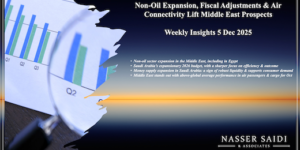Markets
US stock indices rose to new records on Thursday, despite surprisingly weak retail sales, industrial production and consumer sentiment indicating that the US economy might be losing momentum – potentially delaying the US Federal Reserve’s first rate hike. Easing monetary policy in China sparked equity rallies in Hong Kong and Shanghai. Eurozone GDP growth increased to a two-year high, with Spain and France posting the strongest growth. Yields on 10-year German Bunds settled at 0.67%, up 12 basis points for the week and 60 basis points from record lows set in April, while 10-year US Treasury yields retreated below 2.15%. The euro stayed near $1.14. Brent crude oil futures traded close to $67 per barrel, up $2 for the week, while West Texas Intermediate held under $60.
Global Developments
US/Americas:
- US retail sales were virtually flat mom (+0.9% yoy) in Apr compared to upwardly revised 1.1% gain in Mar.
- The US Federal government ran a surplus of USD 156.7bn in Apr, compared with USD 106.8bn yoy. Revenues rose 14% to USD 471.8bn, and spending ticked upward by 2.5% to USD 315bn.
- Initial claims for unemployment benefits were almost unchanged from 265,000 to 264,000. The four-week moving average fell from 280,000 to 272,000.
- US industrial production fell -0.3% mom in Apr; manufacturing output was flat, and March’s gain was revised up from 0.1% to 0.3%.
- The University of Michigan consumer confidence index, plunged from 95.9 to 88.6, the largest tumble in two years due to dismal household finances and more pessimism over business conditions for the next 12 months.
Europe:
- The Eurozone’s GDP grew 0.4% qoq in Q1, vs 0.3% in Q4, propelled by the drop in energy prices. Among the individual countries France and Italy surprised on the upside with +0.6% qoq and 0.3% qoq respectively, while Germany disappointed with a +0.3% qoq.
- Euro zone industrial production decreased -0.3% mom (1.8% yoy) in Mar, following a revised 1% mom (1.9% yoy) increase in Feb. However, UK industrial production rose 0.5% mom in Mar after a paltry 1% mom in the Feb.
- Euro zone CPI grew 0.3% yoy in Apr easing concern about deflation. Among the individual countries, Germany’s CPI increased 0.4% yoy in Apr, following a revised 0.3% yoy increase in Mar, France’s CPI was up just 0.1% yoy in Apr as a result of weak energy prices, Spain’s CPI fell -0.6% yoy in Apr following a -0.6% decline in Mar and Italy’s CPI fell -0.1% yoy in Apr from when it was stalled in Mar.
- UK unemployment rate fell to 5.5% in Q1, the lowest in six years, from 5.6% in the previous period.
- Germany’s trade surplus narrowed to EUR 19.3bn in Mar from Feb’s revised EUR 20bn.
Asia and Pacific:
- China’s industrial production grew 5.9% yoy in Apr, up from 5.6% in Mar. The recovery originated from crude oil and electricity production.
- China’s M2 money supply growth slowed down to 10.1% yoy in Apr., down from 11.6% increase in Mar. China’s fixed asset investment decelerated to 12% yoy in Apr., slower than Mar’s 13.4% rise. The housing slump and industrial overcapacity continue to weigh on credit demand.
- Japan’s consumer confidence index dipped to 41.5 in Apr from Mar’s 41.7. Prospects in employment, income and spending continue to improve despite Apr’s index softening.
- India’s WPI declined 2.65% yoy in Apr. after falling 2.3% in March. The slip in oil and food prices contributed dramatically in this decline.
- India’s industrial production disappointed expectations expanding only 2.1% yoy in Mar, after a 5% rise in Feb. India’s trade deficit was USD 11bn in Apr, slightly lower than Mar.
- Hong Kong’s GDP rose 0.4% qoq in Q1 up from a downwardly revised 0.2% in Q4. The economy continues to recover from the street protests in late 2014.
- Malaysia’s GDP grew a solid 5.6% yoy in Q1, down from Q4’s revised 5.7% gain.
Bottom line: With the release of GDP data from Euroland the picture for all major economies in Q1 remains mixed. Euroland is performing markedly better than the US, but China remains in the doldrums although the smaller peripheral Asian countries appear to have rekindled their growth path.
Regional Developments
- The meeting in Doha of GCC‘s Financial and Economic Cooperation Committee resulted in the adoption of a draft agreement on VAT, which will be endorsed by member governments. While no time frame or rate was specified, it was stated that each jurisdiction would implement its own VAT law.
- Egypt expects 5-6% GDP growth in the next financial year from an expected 4% this year (average economic growth was at 5.6% in H1), as a result of implementing many reforms including the reduction of state subsidies, new taxes and amending an investment law to be more amenable to foreign investors.
- Annual urban consumer inflation in Egypt slowed to 11% in Apr (Mar: 11.5%) while core inflation also eased slightly to 7.19% from Mar’s 7.21%.
- Iraq’s oil and energy parliamentary energy Committee revealed an accumulated debt of USD 22bn for international oil companies operating in Iraqi oil provinces. A committee member also stated that “the ministry has to find an agreement formula with the oil companies to end the debt problem”.
- With lower oil prices, Iraq will reduce its investment spending for 2015 by over 80%, according to a spokesperson for the Ministry of Planning. The country is facing a USD 25bn budget deficit due to the drop in oil revenues; its budget was based on an oil price of USD 56 and targeted (but currently unachievable) crude oil production of 3.5mn barrels per day.
- Inflation in Jordan dropped by 1.1% yoy but was up 0.3% mom in April 2015. Prices were down 1% in Q1, supported by a decline in prices in transportation (15.7%), fuel and lighting (11.7%), vegetables and dried and canned legumes (7.9%).
- Jordan’s public debt rose to JOD 20.8bn, or 76.8% of estimated GDP, at the end of March. net public debt was around JOD 20.5bn or 80.8% of GDP as of end-2014.
- The IMF called for Lebanon to increase VAT rates alongside reducing electricity subsidies and investing more on infrastructure to support economic growth.
- Lebanon’s Finance Minister revealed that the country would lose the USD 600mn soft loan provided by the World Bank if Parliament failed to meet and approve the draft budget.
- Tourists in Lebanon grew by 21% yoy in Q1, according to a report by the Committee of the World Tourism Organization for the Middle East. It also stated that tourism activity grew by 6% in Q3 2014, following a drop from 2.2mn tourists in 2010 to 1.3mn in 2013.
- Oman inflation declined 0.14% yoy in Apr, and was down 0.24 % mom.
- Oman’s power consumption is increasing steadily and the average rise is estimated to be anything around 8 to 9 % per year.
- Total premiums in Oman’s insurance sector increased 10% to OMR 396.5mn in 2014, compared with OMR 359.9mn the previous year, according to the Capital Market Authority.
- Qatar‘s international reserves increased to USD 39.5bn in Mar, from USD 39.1bn at end-Feb, bringing the import cover up to 7.3 months.
- Inflation in Qatar dropped to 0.9% yoy in Apr (Mar: 1.1%); housing and utility costs were up 3% yoy while food and beverage costs gained 0.3%.
- Qatar plans to have 2% of its power output or 1.8 gigawatts (GW), accounted for by renewable resources by 2020, according to a report. Qatar Solar Technologies chairman also revealed that plans are ongoing to increase Qatar’s solar energy output to 2.5GW per year.
- Saudi Arabia’s market opening has once again raised the issue of index classification: “in terms of timing, if all stars were to align, one could imagine the introduction of Saudi stand-alone index into MSCI’s flagship index of emerging markets would be in June of 2017”, according to the head of index research at MSCI.
- Crude oil production in Saudi Arabia touched another record high in Apr, pumping 10.308 million barrels per day (bpd) versus 10.29mn bpd in Mar, according to an industry source.
- MENA IPO activity declined in Q1 2015: according to EY, capital raised through IPOs declined 80% yoy and 97% mom while the number of IPOs dipped 60% yoy and 75% mom. Egypt was the only market to see IPO activity in Q1 2015.
UAE Focus
- Inflation in Dubai touched 4.2% yoy in Apr, close to a 5-year peak, and rising 0.23% mom, with prices of furnishings and home maintenance in addition to housing, electricity, gas and other fuel costs surging by 7.3% and 7.1% respectively. In Abu Dhabi, inflation edged up by 0.2% mom, with restaurants and hotels category registering the steepest price increase of 2.8% mom.
- Free zone trade accounted for 33% of UAE’s total non-oil trade in 2014, according to the Minister of Economy. He also revealed that the country attracted FDI worth USD 11.85bn last year, compared to just USD 4bn in 2009.
- The Dubai Economy Tracker, published jointly by Emirates NBD and Markit, surveys real estate agents and households on a bi-monthly basis to gauge trends in Dubai’s real estate sector. The report for April showed signs that growth momentum has slowed, including a reduction in new international sales enquiries, from its peak seen at the start of 2015.
Media Review
Modi’s spark is not a boom in India
http://www.ft.com/intl/cms/s/0/d019de08-f8af-11e4-be00-00144feab7de.html#axzz3a0Mtvs1A
The oil market remains loose according to the EIA
http://www.ft.com/intl/cms/s/0/82de2a06-f943-11e4-be7b-00144feab7de.html
Obama’s iron-clad commitment to Gulf security
http://www.zawya.com/story/Obama_vows_to_stand_by_Gulf_allies_amid_concern_over_Iran_threat-TR20150515nL1N0Y518WX3/
Oman’s urgent need for fiscal reform
http://www.thenational.ae/business/economy/imf-mission-chief-tells-oman-to-make-urgent-progress-on-cutting-subsidies
Lebanese banking sector has a low level of vulnerability: Fitch Ratings
http://www.zawya.com/story/Lebanese_banking_sector_has_low_level_of_vulnerability-DS11052015_dsart*297432/
Lebanon: Concluding Statement of the IMF 2015 Article IV Mission
https://www.imf.org/external/np/ms/2015/051415.htm







